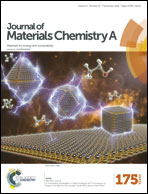High efficiency organic photovoltaic devices based on isoindigo conjugated polymers with a thieno[3,2-b]thiophene π-bridge†
Abstract
Two novel conjugated polymers based on benzo[1,2-b:4,5-b′]dithiophene (BDT) and isoindigo units linked with a 3-octylthieno[3,2-b]thiophene unit as a π-bridge were designed and synthesized. The two polymers named PBDT-TT-IID and PBDTT-TT-IID with the same acceptor unit and different donor unit showed similar molecular weight, absorption spectrum range, and molecular energy levels. Introduction of a thienyl group in PBDTT-TT-IID increased the conjugation degree of the backbone, expanded the absorption spectrum and improved the hole mobility. The film absorption spectrum of PBDTT-TT-IID exhibited a strong shoulder peak at 697 nm, which is attributed to the strong aggregation and highly ordered packing of the polymer chains in the solid state. The power conversion efficiencies (PCEs) of the polymer solar cells (PSCs) based on PBDT-TT-IID and PBDTT-TT-IID achieved 6.31% and 8.05%, respectively. This is first time that efficiency over 8% based on isoindigo conjugated polymers in conventional devices, and it also has the possibility of further improvement. Moreover, these two polymers showed extremely high charge carrier transport including hole and electron mobilities on the 10−2 cm2 V−1 s−1 magnitude. This shows their potential as high efficiency materials in polymer solar cells.
![Graphical abstract: High efficiency organic photovoltaic devices based on isoindigo conjugated polymers with a thieno[3,2-b]thiophene π-bridge](/en/Image/Get?imageInfo.ImageType=GA&imageInfo.ImageIdentifier.ManuscriptID=C6TA07138D&imageInfo.ImageIdentifier.Year=2016)

 Please wait while we load your content...
Please wait while we load your content...